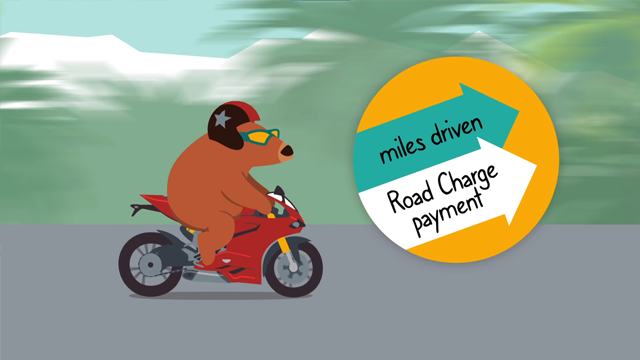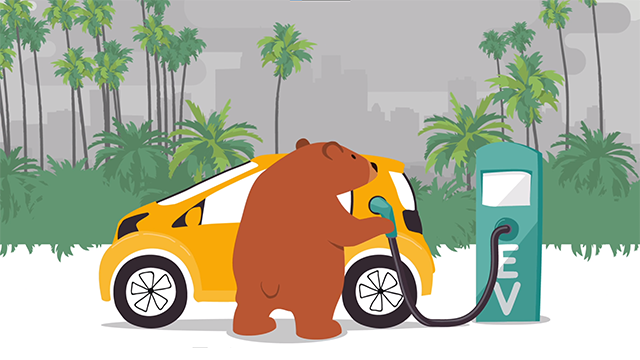FAQs
- How is transportation funded now?
-
A funding system first approved in 1923
On average, Californians pay about $300 a year in state gas taxes that are charged at the pump when a driver buys gas. This money helps keep both local roads and state highways in good repair. Other state fees also fund transportation, and some counties also charge a local sales tax to further invest in road and transit needs.
Learn more about transportation funding - What is a road charge?
-
Replacing California's gas tax
Road Charge is an alternative funding mechanism that allows drivers to support road and highway maintenance based on how many miles they drive, instead of how many gallons of gas they use. Just like you pay your gas and electric bills based on how much of these utilities you use, a road charge - also called a mileage-based user fee - is a fair and sustainable way to fund road maintenance, preservation, and improvements for all Californians. Instead of paying the state’s gas tax, which disproportionately impacts those who cannot afford more fuel-efficient vehicles, everyone would pay a per-mile fee for how much they use the road, regardless of what kind of car they drive.
Learn more about road charge - Why is California studying road charge?
-
A more sustainable way to fund our roads
As Californians switch to more fuel-efficient vehicles, they buy less gas and pay less gas tax. This means less and less funding to maintain our transportation system. California is leading the way on developing new and innovative ways to move around the state; we need a modern transportation funding system to replace the gas tax that can adapt to and keep up with our state’s changing needs.
Learn more about California's projects - Why not just continue to raise the gas tax?
-
California needs a modern transportation funding system
California leads the nation when it comes to driving more fuel-efficient and zero-emission cars. That’s a good thing! However, because these cars consume less or no gas at all, funding highway and road repairs based on a gas tax no longer works. Even if we keep increasing the gas tax, with fewer Californians buying gas the funding will eventually disappear. California needs to replace the gas tax with a funding system that supports our state’s transportation future.
Learn more about California’s gas tax history - What is the estimated relative cost per household of a road charge versus a gas tax?
-
Previous studies have shown that on average, most driving households – including urban/rural and low/high income households – would not see a significant change in how much they pay if California were to change from a gas tax to a road charge system.
However, there will be a more significant change for drivers of zero-emission vehicles who currently contribute very little money to highway and road repairs because they consume very little gas. The amount of the increase will depend on how much they drive, but these incremental ongoing costs are not expected to change driving behavior or car purchasing decisions.
Additionally, if the state’s roads and highways were kept in better condition, it would lead to a decrease in costs for vehicle repairs. Research estimates that Californians spend an average of $840 annually on vehicle repair costs due to poorly maintained roads.
- How would road charge impact lower income families and/or rural households?
-
Supporting equity is a critical goal for the state and for the road charge program in particular. The current system for funding highway and road repairs based on the gas tax means that, all else equal, people who own less fuel-efficient vehicles pay more because they burn more fuel. Since research shows that rural and low-income households tend to own vehicles with lower fuel efficiency, this means they pay more per mile driven than wealthier and urban households. Road charge is designed to fix this inequity so that everyone pays the same amount per mile driven.
- How would road charge impact Californians who drive electric and other fuel-efficient vehicles?
-
Right now, people who drive electric and other fuel-efficient cars contribute less money for road and highway repairs than people who drive less fuel-efficient cars, even though all vehicles cause wear and tear to California’s roadways and contribute to road congestion. The purpose of road charge is to ensure that everyone pays their fair share for road maintenance based on how much they drive, not the kind of car they own.
Importantly, this change in incremental ongoing costs is not expected to change car purchasing decisions, which research shows are highly influenced by federal and state subsidies and special access to carpool lanes. So it won’t impact California’s ability to achieve our zero-emission vehicle and greenhouse gas reduction goals.
- When is California going to enact road charge?
-
In an effort to ensure California’s transportation funding system can keep up with changing technology and modes of transportation, in 2014, the California State Legislature passed SB 1077 (DeSaulnier) to study road charge as one potential option. As part of the state’s study, the California’s Road Charge Pilot Program launched on July 1, 2016 and ran for nine months to test the possibility of funding road and highway repairs based on how many miles a driver travels instead of how much gas they purchase.
Since then, the state has continued collaboration with its partners and with other states to design, develop, and demonstrate a road charge program that will sustainably support California’s transportation repair and maintenance needs now and in the future. No decisions have been made yet about how, when, or whether to implement road charge – or any other new transportation funding model.
Share your thoughts on what a road charge program might look like
- What is happening at the national level regarding road charge?
-
Congress passed the $1.2 Trillion Bipartisan Infrastructure Bill (BIL) in 2021 that included the first ever National Pilot and extended funding to the states through the Strategic Innovation for Revenue Collection program.
The National Pilot
The BIL calls for spending $50 million over five years on a national pilot to test and demonstrate technology for collecting a motor vehicle per-mile user fee. Many details are still being discussed.
The Strategic Innovation for Revenue Collection Program
The BIL establishes the Strategic Innovation for Revenue Collection program to provide discretionary grants to test the feasibility of a road usage fee and other user-based alternative revenue mechanisms to help maintain the long-term solvency of the Highway Trust Fund. The US Department of Transportation Federal Highway Administration (FHWA) implemented a similar predecessor program, the Surface Transportation System Funding Alternatives (STSFA) Program for the last several years, with a five-year $95 million competitive grant program. California successfully applied for five years of funding through STSFA grant program.




